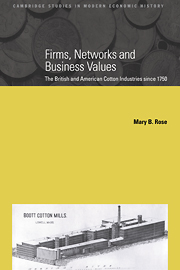Book contents
- Frontmatter
- Contents
- List of figures
- List of tables
- Acknowledgements
- 1 Introduction: the evolution of two industries
- Part I The culture of business networks 1750–1860
- 2 Industrialisation and the cotton industry in Britain and the United States
- 3 Family firms, networks and institutions to 1860
- 4 The management of labour to 1860
- 5 Networks and the evolution of government–industry relations to 1860
- Part II Continuity and change
- References
- Index
- Cambridge Studies in Modern Economic History
3 - Family firms, networks and institutions to 1860
Published online by Cambridge University Press: 12 September 2009
- Frontmatter
- Contents
- List of figures
- List of tables
- Acknowledgements
- 1 Introduction: the evolution of two industries
- Part I The culture of business networks 1750–1860
- 2 Industrialisation and the cotton industry in Britain and the United States
- 3 Family firms, networks and institutions to 1860
- 4 The management of labour to 1860
- 5 Networks and the evolution of government–industry relations to 1860
- Part II Continuity and change
- References
- Index
- Cambridge Studies in Modern Economic History
Summary
Historically family firms have been vital during industrialisation throughout the world and were synonymous with the early development of cotton textiles in both Britain and the United States. Whether as the result of institutional failure stemming from underdevelopment, or as a reflection of pre-industrial wealth patterns, or a combination of the two, family businesses lay at the heart of the First Industrial Revolution on either side of the Atlantic. In eighteenth-century Britain family firms proliferated in most branches of manufacturing, commerce and finance. With the spectre of bankruptcy ever present in the hazardous world of the eighteenth and nineteenth centuries, a combination of the common law partnership and unlimited liability meant that many businessmen preferred to be associated with their family connections than with outsiders. This was less a reflection of conservatism than a strategy to ameliorate the worst effects of uncertainty. In the United States too, the regional take-off of New England and Pennsylvania was based upon personal capitalism which proved crucial in the cotton industry. Similarly in the Southern states the, admittedly limited, development was founded on family-based, community-oriented firms.
The popularity of family business in the early British and American cotton industries in both manufacturing and commercial arrangements was, therefore, a predictable response to instability. However, national differences in the sources of uncertainty, in economic circumstances, in the institutional environment and in that complex array of historical forces which shape both business and national culture mean that, whilst ownership and control were united in both countries, the form which this took and the strategies pursued were at times strikingly different (Gerschenkron 1953: 1–19; Kindleberger 1964: 113–14).
- Type
- Chapter
- Information
- Firms, Networks and Business ValuesThe British and American Cotton Industries since 1750, pp. 58 - 98Publisher: Cambridge University PressPrint publication year: 2000

